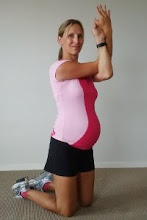During your Pregnancy it is crucial from the start that you try to develop and or maintain good posture.
Good posture is beneficial for both you and your baby. Here are some of the key benefits
• Gives baby more room to grow and move
• Reduces lower back, shoulder, neck and pelvis pain
• Increases recovery post birth
• Reduces diastasis recti-abdominal separation
Good posture increases the room your baby has to grow and develop. This puts less strain on you and you will carry your pregnancy far easier. Poor posture decreases the room which baby has to move and will cause excess tightening of some muscle groups causing posture to worsen. A good example of poor posture leading to less room is rounded shoulders and weak core muscles.
An Example of Good Posture in late Pregnancy 38 weeks with Twins
Poor posture will increase lower back and hip pain during pregnancy. Lower back pain can be caused by excessive lumber lordosis. This puts extra strain on the lower back muscles whilst weakening the gluteus (butt) muscles and over tightening the Quadriceps muscles (your thighs).
Excessive arching of the lower back as seen in the example will lead to lower back aches and pains. This posture will also increase premature diastasis recti-abdominal separation.
How will good posture increase my recovery post birth?
Once you have good posture your body is functioning correctly and you will have optimal muscle balance. Good muscle balance and strength increases recovery as poor posture in pregnancy generally worsens post birth, increasing the chances of injury and developing muscle aches and pains.
Diastasis recti- abdominal separation generally occurs during the 3rd tri-mester but in 2nd and multiple pregnancies it can occur earlier. If you continually sway your back and or stick your tummy out, this will put pressure on the weakened abdominal muscles earlier in the pregnancy causing premature separation.
What you need to do:-
You need to think about your posture daily and you need to make the changes to correct your own posture.
Good and Poor Posture at 21 weeks, which one are you? You can change it!
Have a look at yourself side on and then front on in a mirror and assess your posture.
Side View:
Your Cheekbones, shoulder and hip should line up in a vertical line
Do you feel balanced?
Are you placing more body weight towards your toes?
Have you got excessive lumber lordosis?
Front View:
Are your shoulders and hips parallel?
Is one hip or one shoulder higher than the other?
Are you standing with more weight on one leg?
If you need to correct any postural issues you need to address this asap and think about your posture frequently. You may even need a corrective exercise trainer or physio to help, especially if you already have aches and pains.The pregnancy programs that I sell on my website cover postural pregnancy exercises http://pregnancyexercise.co.nz
Make adjustments to your posture as your pregnancy progress's. Make changes daily and try to think about how you are standing and sitting.
Here are a few Good Posture tips:
Lift your chest up
Look forward
Imagine you are being pulled upwards from your head by a piece of string
Tilt your hips underneath you
Avoid sitting with crossed legs
Avoid standing on one hip or weight on one side
Avoid carrying small children on the same side
Good posture is good for you and great for your pregnancy
Monday, December 5, 2011
The Importance of Good Posture during Pregnancy
 20 years Experience in the Fitness Industry. A Personal Trainer and Corrective Exercise Specialist.
I have specialized in Pregnancy and Post Natal Exercise for more than 15 Years.
My company Pregnancyexercise.co.nz is dedicated to providing professional advice during your pregnancy and beyond. I want all women to benefit from exercising both during and post pregnacy. I try to achieve this through this blog, my website and facebook sites. http://pregnancyexercise.co.nz for On-line Pregnancy and Post Natal Exercise Programs
20 years Experience in the Fitness Industry. A Personal Trainer and Corrective Exercise Specialist.
I have specialized in Pregnancy and Post Natal Exercise for more than 15 Years.
My company Pregnancyexercise.co.nz is dedicated to providing professional advice during your pregnancy and beyond. I want all women to benefit from exercising both during and post pregnacy. I try to achieve this through this blog, my website and facebook sites. http://pregnancyexercise.co.nz for On-line Pregnancy and Post Natal Exercise Programs
Subscribe to:
Post Comments (Atom)




iwll
ReplyDeleteI'm 6 weeks pregnant and I want so badly to improve my posture and start squatting. This is my problem: just before I turned 8yrs old my right femur was fractured in a car accident and when the bone healed it overgrew leaving my right leg longer than my left. I also have limited range of motion in that same leg due to scar tissue and my knee is really shakey. I'm supposed to be fitted for a new heel lift soon. I can squat but probably not to a 90 degree angle and when I do I find myself favoring my weak side and putting more of my weight on the other side. Do you have any modified squats or alternative exercises? Should my posture be different due to unequal leg length?
ReplyDeleteHi Tyra, Congratulations! why don't you email me for a free trail exercise program for first trimester it will be perfect for you lorraine@pregnancyexercise.co.nz
ReplyDelete